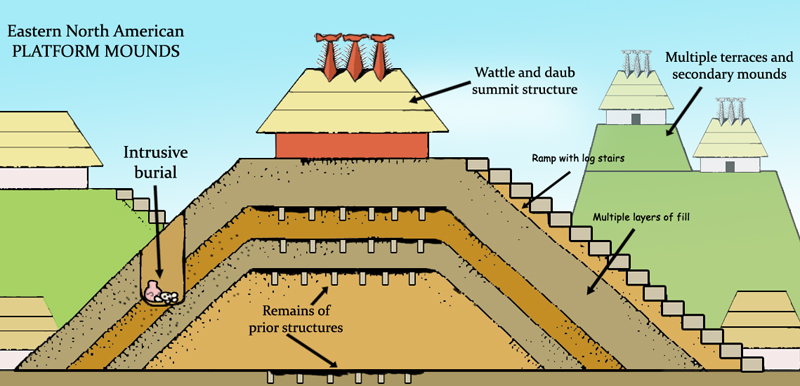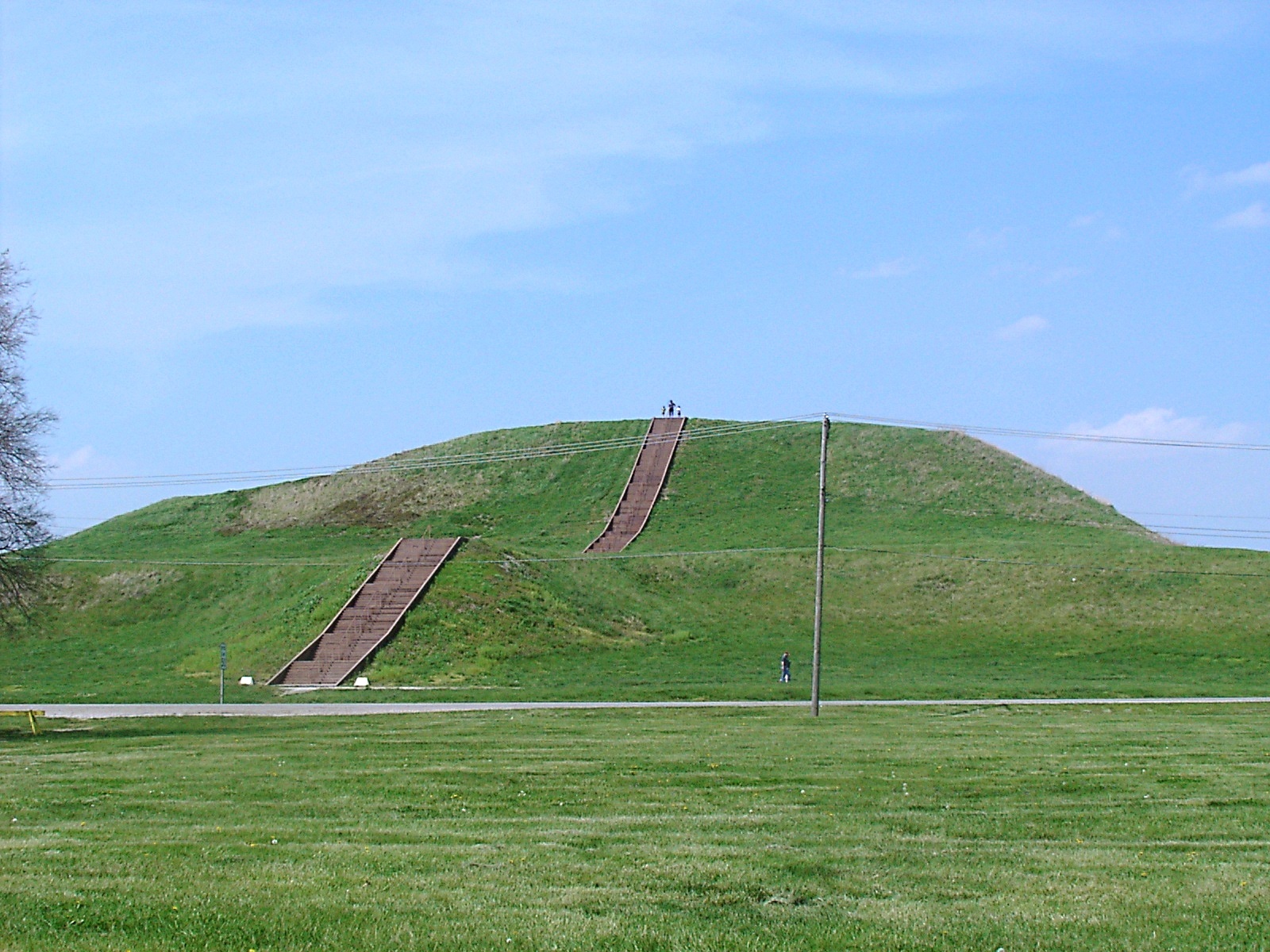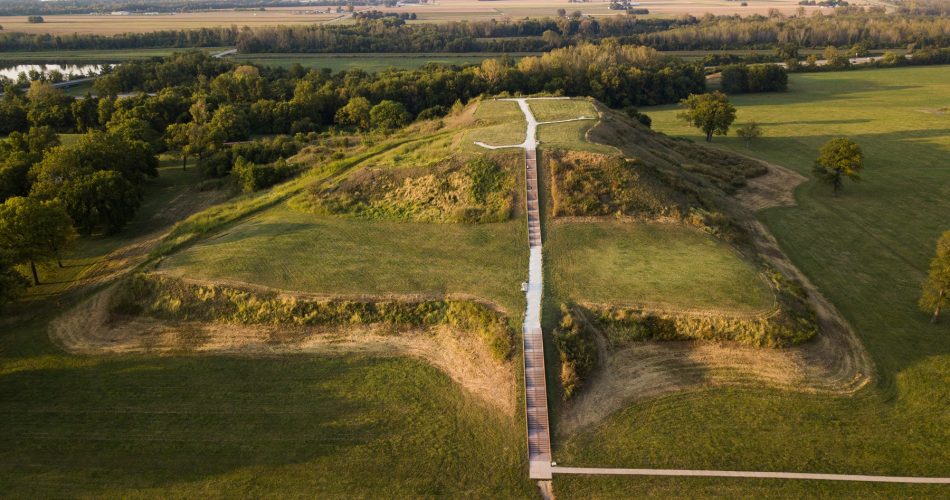- The Pyramid city of Cahokia is home to more than 120 pyramidal structures
- The largest of these is the so-called Monks Mound.
- Monks Mound is truly massive; it is roughly the same size at its base as the Great Pyramid of Giza; 13.1 acres / 5.3 hectares.
- The perimeter of Monks Mound base has been measured to be larger than that of the pyramid of the Sun at Teotihuacan in Mexico.
- Monks mound is believed to contain as many as 22 million cubic feet of adobe, carried basket by basket to the site.
Pyramidomania, there are pyramids spread across the entire planet. Throughout history, ancient civilizations build pyramids in many parts of the planet. The most famous pyramids are those of Egypt; the Great Pyramid of Khufu, that of Khafre and the third-largest at Giza, the pyramid of Menkaure.
The largest pyramid on the surface of the planet is located in Central America, in present-day Mexico. Called the Great Pyramid of Cholula, this supermassive structure is not only the largest pyramid on the surface of the planet but also the largest monument ever built anywhere on Earth.
For several thousand years, pyramids were the most massive structures built by human hands. In Egypt, the history of pyramids can be traced back to Djoser’s Third Dynasty Reign when his royal vizier and architect Imhotep planned, designed and built the earliest colossal stone building in Egypt. With a total volume of 330,400 cubic meters (11,667,966 cu. ft.) it was a revolutionary, unprecedented monument in Egypt, one that would kick start a pyramid-building fever that lasted in Egypt for a thousand years.
The oldest pyramids are believed to be monuments built more than five thousand years ago in present-day Brazil.
However, in addition to the more popular pyramids like those of Egypt, Sudan, Indonesia or even Mexico, there are pyramids in Northern America as well.

An image of a diagram showing the interior structure that makes up the platform mounds at Cahokia. Image Credit: Herb Roe / Wikimedia Commons / CC BY-SA 3..
In fact, the United States boasts a massive pyramid city called Cahokia ( 38°39′38.4″N 90°3′43.36″W ).
History tells that numerous ancient cultures in America built pyramids, either more simplistic monument such as those in Brazil, or more elaborate monuments like the Great Pyramid of Cholula, or the pyramids at the ancient city of Teotihuacan. In North America, native American cultures erected large pyramidal structures that are known as pyramidal platform mounds.
The best example of such architecture is located in present-day Illinois where a monument known as the Monks Mounds stands proud and tall.
Completed around 1100 AD, the Monks Mound Pyramid has a base that is much larger than that of the Great Pyramid at Giza. although perhaps not as elaborate in terms of precision and design, Monks Mound is a structure worthy of praise.
Analysis of sites such as Cahokia has helped experts understand that various ancient mounds underwent repetitious episodes of construction spread out across periodic intervals.
Although Monk’s Mound–seen in the image above–is the largest pyramidal structure in Cahokia, surveys of the site have revealed that the ancient city once boasted as many as 120 similar structures ranging in size.
The settlement of Cahokia was already an influential metropolis and a large settlement of importance in the Mississippian region approximately one thousand years before the Europeans set foot on the American Continent. It is believed that around 1,000 CE the city grew further in importance thanks to trade and manufacturing. However, surveys of the larger are have revealed that people inhabited the area prior to 1,200 BC. Despite the fact that the society that built the mounds did not leave behind written records, symbols painted on various artifacts is evidence of the complexity of the people of Cahokia.

Monks Mound at Cahokia. Thousands of years ago, this pyramidal structure was one of the main buildings in the city. Image Credit: Wikimedia Commons / CC BY-SA 3.0.
The city we call Cahokia today was actually called differently in the past. However, because of the lack of written records, we don’t really know what its original inhabitants called the city. The name we used today to refer to the pyramid-mound city comes from the Cahokia tribe, a historic Illiniwek people occupying the area when the first French colonists arrived in the 17th century.
Although the ancient culture that inhabited Cahokia is long gone, its monuments, devoured by nature remain and are considered some of the largest most sophisticated sites in Northern America, comparable nearly to structures built by neighboring ancient cultures to the south in present-day Mexico.
Monks Mound Pyramid
Although the city of Cahokia boasted many pyramidal structures, none was as massive and complex as Monks Mound. It is thought that its construction began around 900 CE, and built in various phases until it became the largest pre-Columbian earthwork in America and the largest pyramid north of the stone pyramids of Mexico. The exact size of Monks Mound was calculated in 1988; it measures 100 feet (30 m) high, 955 feet (291 m) long and 775 feet (236 m) wide. Despite its current, massive size, experts argue that the original concept may have been a much smaller mound. This pre-structure is now believed to be buried inside the northern end of Monk’s Mound.
Studies of Monks Mound suggest that as many as ten different construction phases were needed to complete the structure. When the pyramid mound was completed, its builders constructed an additional, temple-like residence on its summit. This building made Monks Mound even taller, and the structure was visible across the city.
Unlike the pyramids of Egypt which are thought to have been sued as tombs, the pyramid-mounds of Cahokia were most likely used for ceremonial and political purposes.
Monk’s Mound, although not built of stone is still a very complex structure; it rises four terraces to a height of 100 feet (30 m) and has a rectangular base that covers approximately 15 acres (6.1 ha). Surprisingly, it contains 22 million cubic feet of adobe. The material is believed to have been carried to the site basket by basket.
The most recent addition to Monks Mound is thought to have been made around 1,200 CE when its builders added the lower terraces at the monument’s southern end.
Monks Mound, together with different albeit smaller mounds, as well as plazas comprised an extremely elaborate city, and no other ancient settlement in Northern America can be compared in terms of architecture and complexity to Cahokia.
The decline of the city and the society of Cahokia remains shrouded in mystery. It is usually agreed that the city declined around 1,300 CE. However, new studies have revealed a different picture. archeologists from UC Berkeley have challenged the narrative we have been accustomed to.
History suggests that by the 1,400s the city was abandoned as a series of floods, droughts and other natural catastrophes struck the region. However, the recent study points to the fact that the exodus may have been very short-lived, and that the City, its pyramid mounds and the surrounding area flourished well into the 1,700s.
Scholars usually maintained that by the time of European contact, the city was already abandoned. However, the new evidence points towards a different timeline, one that suggests that the pyramid city of North America endured for longer than what historians initially thought.

